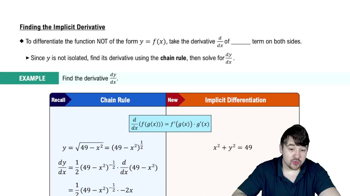Table of contents
- 0. Functions7h 52m
- Introduction to Functions16m
- Piecewise Functions10m
- Properties of Functions9m
- Common Functions1h 8m
- Transformations5m
- Combining Functions27m
- Exponent rules32m
- Exponential Functions28m
- Logarithmic Functions24m
- Properties of Logarithms34m
- Exponential & Logarithmic Equations35m
- Introduction to Trigonometric Functions38m
- Graphs of Trigonometric Functions44m
- Trigonometric Identities47m
- Inverse Trigonometric Functions48m
- 1. Limits and Continuity2h 2m
- 2. Intro to Derivatives1h 33m
- 3. Techniques of Differentiation3h 18m
- 4. Applications of Derivatives2h 38m
- 5. Graphical Applications of Derivatives6h 2m
- 6. Derivatives of Inverse, Exponential, & Logarithmic Functions2h 37m
- 7. Antiderivatives & Indefinite Integrals1h 26m
- 8. Definite Integrals4h 44m
- 9. Graphical Applications of Integrals2h 27m
- 10. Physics Applications of Integrals 2h 22m
4. Applications of Derivatives
Implicit Differentiation
Problem 3.8.19b
Textbook Question
13-26 Implicit differentiation Carry out the following steps.
b. Find the slope of the curve at the given point.
cos y = x; (0, π/2)
 Verified step by step guidance
Verified step by step guidance1
Start by differentiating both sides of the equation with respect to x. For the left side, differentiate cos(y) using the chain rule: the derivative of cos(y) is -sin(y) times the derivative of y with respect to x, which is dy/dx. For the right side, the derivative of x is 1.
Write the differentiated equation: -sin(y) * (dy/dx) = 1.
Solve for dy/dx by isolating it on one side of the equation. This involves dividing both sides by -sin(y), giving dy/dx = -1/sin(y).
Substitute the given point (0, π/2) into the equation to find the slope at that point. Since y = π/2, substitute π/2 for y in the expression for dy/dx.
Evaluate sin(π/2) to find the slope. Since sin(π/2) = 1, substitute this value into the expression for dy/dx to find the slope at the point (0, π/2).
 Verified video answer for a similar problem:
Verified video answer for a similar problem:This video solution was recommended by our tutors as helpful for the problem above
Video duration:
2mPlay a video:
Was this helpful?
Key Concepts
Here are the essential concepts you must grasp in order to answer the question correctly.
Implicit Differentiation
Implicit differentiation is a technique used to differentiate equations where the dependent and independent variables are not explicitly separated. Instead of solving for one variable in terms of the other, we differentiate both sides of the equation with respect to the independent variable, applying the chain rule as necessary. This method is particularly useful for curves defined by equations that cannot be easily rearranged.
Recommended video:

Finding The Implicit Derivative
Slope of a Curve
The slope of a curve at a given point represents the rate of change of the dependent variable with respect to the independent variable at that specific point. Mathematically, it is found by evaluating the derivative of the function at that point. In the context of implicit differentiation, the slope can be expressed as dy/dx, which indicates how y changes with respect to x.
Recommended video:

Summary of Curve Sketching
Evaluating Derivatives at a Point
To find the slope of a curve at a specific point, we first compute the derivative of the function and then substitute the coordinates of the point into this derivative. This process allows us to determine the instantaneous rate of change at that point. For the given problem, substituting the point (0, π/2) into the derived expression for dy/dx will yield the slope of the curve at that location.
Recommended video:

Critical Points

 5:14m
5:14mWatch next
Master Finding The Implicit Derivative with a bite sized video explanation from Nick
Start learningRelated Videos
Related Practice


